Autumn Exhibition 2022
Pubs of Yeovil - lost forever
Autumn Exhibition 2022 - presented by Yeovil's Virtual Museum
Introduction
Yeovil has
always had a lot
of pubs - in
fact, I
discovered
Yeovil had 147
(albeit not all
at the same
time) plus more
than 100
un-named
beerhouses.
Indeed, between
the 1860's and
the 1960's there
were always more
than 50 pubs in
the town - and
this at a time
when the town
was much smaller
than today.
Until the middle of the 20th century the vast majority of Yeovil's licensed premises were what might be classed as town centre pubs simply because the town itself was relatively small. Many of these were swept away in the wholesale redevelopment of Yeovil between the 1960's and the 1980's and the ubiquitous road widening schemes. Of course, with the increase in pub closures over the past few years and bending to the pressures of modern economics, quite a few former pubs have been converted into flats or demolished and replaced by small blocks of flats or other accommodation.
When I first moved to Yeovil in 1973 I had a map on the wall of my office with a red dot for each of the pubs in town I had visited within the first year of moving to Yeovil - all 40 of them. In those days our regular Gentlemen's Cultural Liquid Refreshment Perambulations (pub crawls) were relatively easy to organise and really didn't involve too much perambulating.
Sadly, there has been a steady national decline in the number of pubs, but with the recent problems brought about by Covid and the current cost of living crisis, the rate of pub closures has increased dramatically - not just in Yeovil, but in towns and cities across the country.
This exhibition highlights, alphabetically, those pubs that, for whatever reason, have closed since the 1960s. Clicking on each pub name will take you to the relevant page, with much more information and many more photos, in Yeovil's Virtual Museum.
![]()
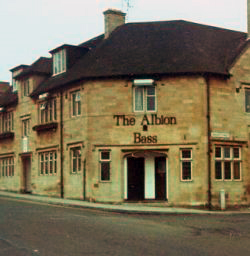 |
The Albion Inn was an old pub in Vicarage Street for many years almost opposite Frederick Place. By the 1890s the
Albion Inn was a
tied house of
the
Royal
Osborne Brewery,
with a long
lease owned by
Earle
Vincent. When Vincent died in 1893, his estate was sold off the following year which included "the Albion Inn at Vicarage Street, at £22 (about £2,200 at today's value), and rented by Mr Hubert Beare." |
It was rebuilt in 1937 by the brewery as a corner site public house at the junction of Vincent Street with Vicarage Street after Vincent Street was built.
The Albion finally closed on 27 March 1983 and demolition began on 30 May 1983, as part of the wholesale redevelopment of the area that became the Quedam shopping centre.
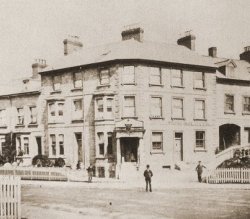 |
The Alexandra
Hotel Yeovil Town Station opened in 1861 and in 1885 the Alexandra Hotel, along with the rest of South Western Terrace, was built by Levi Ridout in its prime location to accommodate railway travellers. A large, imposing building on a corner site and built to directly face the station and impress travellers - for many of whom it would be their first impression of Yeovil. |
The new hotel
was named, in a
flurry of
patriotism,
after the
popular Princess
Alexandra of
Denmark
(1844-1925)
became the
consort of King
Edward VII when
they married in
March 1863,
shortly before
the hotel
opened. It
closed around
2010, re-opened
as a renamed
hotel.
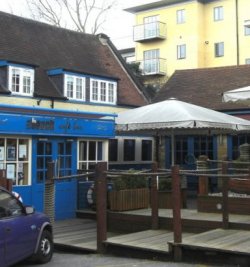 |
Converted from the old social club of the Southern Electric Board called the Wessex Social Club, it became an Australian-themed bar called Alice Springs in (I think) the 1990's, It was then called the Beach and was a haunt of the young and trendy - alas I no longer fit either category so only entered once, although I used to skittle here regularly when it was a social club. It is now an excellent Italian restaurant, Castello's. |
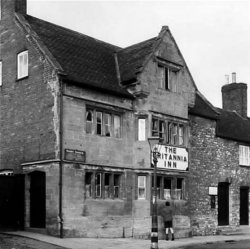 |
The
Britannia
Inn The Britannia Inn was originally a fine 17th century two-storey brick house with stone and ashlar to the front elevation with a double-storey projecting bay. It served as a public house from 1861 - after the closure of the first Britannia Inn listed in Belmont from 1842 to 1861. This second Britannia Inn was demolished, brick by brick, in 1969 and the materials used to build a private house at Ash. |
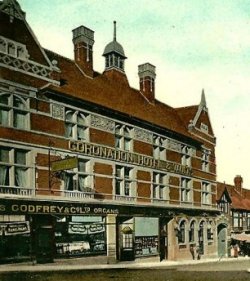 |
The Coronation
Hotel &
Vaults
The Coronation Hotel & Vaults was an impressive, albeit relatively short-lived, establishment in Middle Street, on the north side of the Triangle. It was built around 1900 on the site of the Blue Ball Inn, itself a pub with an apparently short lifespan. The Coronation Hotel & Vaults, owned by Mitchell, Toms and Company, opened on Thursday 17 July 1902 and was designed by architect Arthur Yeomans. |
The Coronation Hotel & Vaults was finally demolished around 1965 as part of the Glovers Walk shopping complex redevelopment. It had served Yeovil for only some fifty years before succumbing to the 'progress' of 1960's concrete and steel architecture - unfortunate for such a grand building and what was surely the most architecturally impressive of Yeovil's watering holes.
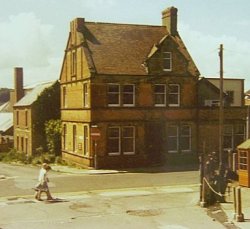 |
Although the Crown was listed as early as 1835, it is not likely that the early Crown Inn was the building photographed here, which is clearly later in style (possibly 1880's or 1890's) and even had a dance hall upstairs. This later version, with the appearance of a purpose-built public house, was more likely to have been owned and rebuilt at a later date by one of Yeovil's breweries as a tied house. |
The Crown Inn closed during the 1970s and for many years was used as the regional office for Bass Brewers. The building was demolished in 1991 as part of the Tesco redevelopment.
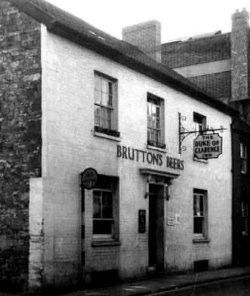 |
The early history of the Duke of Clarence is something of a mystery. Certainly the inn was once known as the Fives Court Inn due to the presence of a fives court at the rear of the premises. The date of this is unknown but is likely to have been during the 18th century, albeit not in the current building. After being known as the Fives Court Inn for many years, by 1790 it was known as the White Hart until the mid-1860's when it is thought the building was rebuilt and assumed the name Duke of Clarence. |
The Duke of Clarence was also colloquially known as the "Young Buck", which must have been a hangover from the days the pub was called the White Hart. It closed in 1965 and in recent years has been run as a succession of bars.
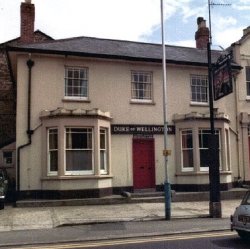 |
Duke of
Wellington The Duke of Wellington was operating as a beerhouse by 1869 at which time it was adjoining a private house called Medina Cottage which later (after 1881) became part of the public house. Judging by its proximity to the Royal Osborne Brewery, it almost certainly was a tied house of that brewery. |
The Duke of Wellington closed (I think) in the very late 1980s and was finally demolished in November 1992.
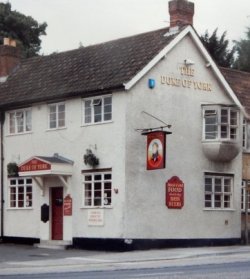 |
Another of Yeovil's old public houses, records go back to at least 1822 when John Swaffield was the landlord. However, this was not housed in the present building, which was rebuilt after 1905. It had a fortunately brief spell when it was renamed "Buddy's", but soon reverted to the Duke of York. It closed in the mid-1990s and the building was sold. It re-opened as the Conservative Club - which it remains today. |
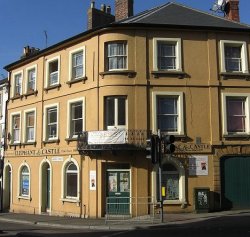 |
Elephant
and
Castle
Inn The Elephant and Castle Hotel was a purpose-built public house / hotel that opened in 1860 on the corner of Lower Middle Street and Wyndham Street. The Elephant and Castle closed in 1977 although the building survives. |
At the end of
the building a
low archway, or
porte-cochere,
with decorative
stone surround
and double doors
gives the
impression that
it leads to
stabling, which
it may have done
in the past,
however because
the Elephant and
Castle occupies
a corner plot
the rear is
wedge-shaped and
very tiny so any
stabling would
have, by
necessity, been
to the side of
the building.
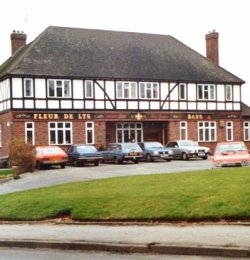 |
Fleur-de-Lys The Fleur de Lys was built in 1936 to serve the Mudford Road / St Michaels Avenue area where much inter- and post-war housing was being developed. In that sense it is a typical 'estate' pub of the period, red brick under a tiled roof in much the same vein as the Green Dragon, Milford Inn, Royal Standard and the Sun. The Fleur de Lys closed during the summer of 2014 and is now a Co-op outlet. |
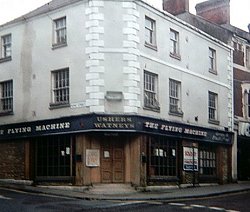 |
Flying
Machine
(New
Inn) This pub was originally called the New Inn. I'm not sure when it first opened its doors as the name 'New Inn' was traditionally applied to a former inn on the site that had been rebuilt after some disaster or other, such as a fire. It is highly probable that such a previous inn was on the site because of its prime town centre location. |
In this case, however, it may have been that the old inn fronted onto Middle Street but was demolished when Bond Street was laid out and constructed around 1830-35 by Peter Daniell, probably by the Crewkerne United Breweries Co. Ltd, whose name was inscribed above the corner doorway - this would fit in with the building's architectural style of the 1840's.
In the 1960's had a brief spell as Applegate's Wine & Spirits shop and in the 1970's it re-opened as a public house named the Flying Machine. Now, of course, it is a branch of the Nationwide Building Society.
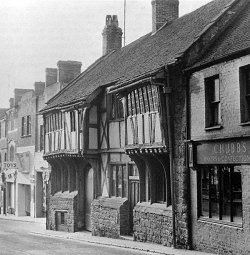 |
George
Inn/Hotel The George Inn began life as a private dwelling, built during the 1400’s and from 1478 it was owned (among other licensed premises) by the Trustees of Woborn's Almshouse, who continued to own it until 1920. It was originally, at least from 1642, called the Three Cups Inn, there already being a George Inn in High Street. It would appear that the Three Cups was renamed the George around 1720. |
The George was a timber-framed building over low stone walls with a jettied (upper floor projecting beyond the dimensions of the floor below) upper storey in the style of a Wealden house. Indeed the George was regarded as the most westerly example of this style of domestic architecture usually found in the southeast of England.
The demise of the George, the last remaining secular medieval building in the town, is a sorry tale indeed. In the early 1960’s the Council, in its wisdom, decided that Middle Street needed widening and that the George had to be demolished as part of the road widening scheme, widely opposed by public opinion. The pub was, sadly, demolished in 1962 but it transpired after demolition that the Council did not own the land and the road widening scheme could not progress and so the pavement where the pub had stood simply jutted out into Middle Street as it always had. Within ten years this section of Middle Street was turned into a pedestrian precinct, obviating the need for a road widening scheme anyway.
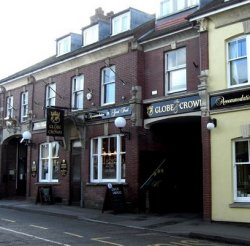 |
The Globe and Crown is first recorded in 1839 as a beerhouse following the enactment of the Beerhouse Act 1830. The architectural style of today's building, combined with an apparent hiatus in the written records, would suggest that the Globe and Crown was rebuilt and became licensed as a public house proper during the late 1860's or early 1870's. It closed in late spring 2022 and is to be re-used as a homeless shelter. |
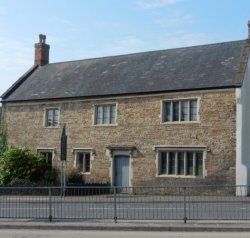 |
The Glovers Arms was originally a 17th century farmhouse at the bottom of Reckleford Hill. It was the home of the Isaac family until the death of yeoman Samuel Isaac in 1849. The building had certainly been a pub since the 1850’s, and was given its name after the demise of the first Glovers Arms - a beerhouse in Brunswick Street. The Glovers Arms closed around 2005 following several fires and has now been converted to flats. |
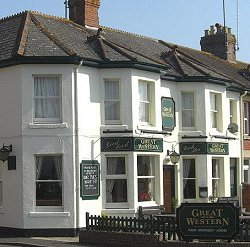 |
A very late 19th century public house, clearly built to serve travellers using Pen Mill railway station and the local domestic market of Camborne Grove, Camborne Place and Camborne Street. It was, for its first year or so, known as the Camborne Inn. The Great Western closed around 2015 and was converted to flats. |
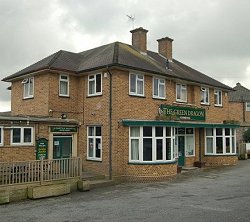 |
Green Dragon Another of those architecturally dreary estate pubs of the 1950’s that were built to serve the new estates being constructed as part of the ever-expanding Yeovil town. As a consequence most, like the Green Dragon, were populated with a very local clientele who tended to cold-shoulder strangers. |
Opening on 18 December 1957 with the Western Gazette calling it "Yeovil's most modern public house". It closed at the beginning of 2016, was soon demolished and a Co-op outlet built on the site.
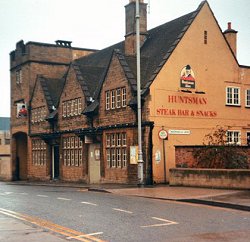 |
The Greyhound The Greyhound had not always been in the building we see today. The original two-story building was a far simpler brick structure with mullioned windows under a thatched roof. It is thought that the old Greyhound Inn building was demolished and the new Greyhound Inn building, much larger than its predecessor, was built around 1906. After it closed in the late 1990s, the building was left empty for many years. It is now The Keep hotel. |
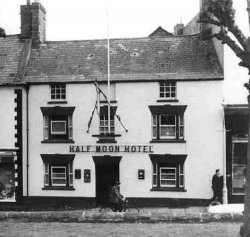 |
The Half Moon Inn in Silver Street was open from at least 1709, when it was mentioned in a Deed of Property. It was presumably named as such to distinguish it from the Full Moon just across the Borough in Wine Street. The Half Moon closed in the 1970s. |
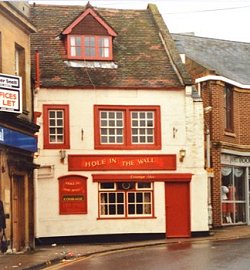 |
This pub was originally known as the Queen's Head, changing to the Queens Arms around 1840 and had been trading at least since 1766. By 1866, after the demise of the beerhouse named the Royal Oak, it was renamed as the Royal Oak or the Royal Oak Inn. During the late 20th century it was renamed the Hole In The Wall and became a restaurant called the Green Room circa 2005. |
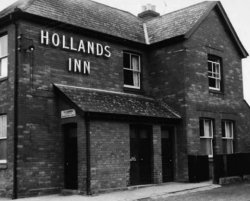 |
Hollands Inn This area between Ilchester Road and Mudford Road, now mostly occupied by the Yeovil College campus, has been named Hollands at least since 1590 after the de Hollande family, Earls of Kent, who held Kingston Manor to the end of the reign of Richard II (1377-1399). |
Similarly, the name of the public house was therefore nothing to do with imported Dutch gin as has been suggested more than once. Closing in the mid-1970s, the Hollands Inn is now a private house off a small private drive, itself off Mudford Road immediately past the bus stop next to the exit of Yeovil College.
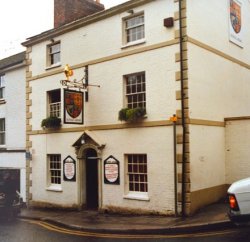 |
King's Arms The Kings Arms Inn had stood for many years in Silver Street but had been known as the Bunch of Grapes and the Grapes Inn and even into the 1940's had, as a sign, a bunch of grapes suspended from a wrought iron bracket. It is
most
likely
that
this
public
house
traded
as the
Bunch of
Grapes
until
about
1855. |
A major fire in 1835 destroyed the building, along with several other premises. Following the fire all the premises from the Kings Arms to the Pall Tavern were rebuilt further back from the road so that Silver Street could be widened - so nothing is new!
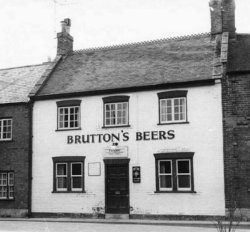 |
Market Street Inn The Market Street Inn was just a few yards along Market Street from the Pall and backed on to the cattle market. It
enjoyed
special
traditional
market
day
opening
hours
that
meant
that
farmers
and
dealers
attending
the
market
could
get a
'wet'
breakfast
at
something
like
seven in
the
morning. |
Several pubs in Yeovil were allowed special market day opening hours on Fridays, basically staying open all day at a time when most pubs only opened for three hours at lunchtime and then closed for the afternoon, opening again later for the evening session. A 'market day afternoon' was once a rare treat, now almost forgotten with today's relaxed 'open all day' licensing laws.
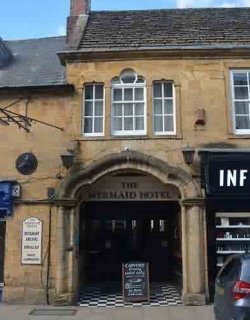 |
The 'Merm' was the oldest surviving licensed premises in Yeovil until it permanently closed in 2019, with the earliest mention in the records being in 1517. Around 1760 "... the whole House (except two Rooms in Front)..." was rebuilt. Originally, of course, the Mermaid was much smaller than it is today, being only that part from the arch and to the east; that part now 1a and 1b High Street to the west of the arch was originally built as a single town house in the late eighteenth century. The
Mermaid
finally
closed
in the
summer
of 2019. |
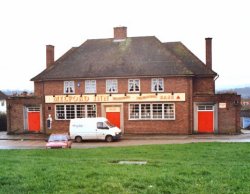 |
Milford Inn One of Yeovil's architecturally uninspired 1950's estate pubs. It had been struggling for years and finally closed in 2012. It is now flats. I did
visit
once -
in the
mid-1970's
- and it
was so
unwelcoming
I never
dared
return. |
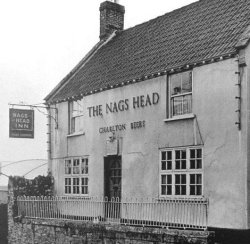 |
The
Nags
Head Inn
was
located
on
Reckleford,
more or
less
opposite
the
Black
Horse
but a
few
buildings
further
down the
hill. It
first
appeared
in the
records
in 1851
and
continued
trading
until
the
1960s.
It was
demolished
in 1963
for the
building
of
Yeovil's
Inner
Relief
Road
(that
part
making
Reckleford
a dual
carriageway)
and its
location
would
have
been
roughly
where
the
current
central
reservation
is now. |
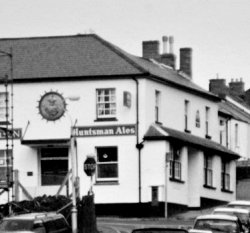 |
The
Nelson
Inn was
a
purpose-built
corner
site
public
house
built on
what is
now the
northern
corner
of the
Eastland
Road /
Gordon
Road
intersection
in the
late
1860's
to serve
the New
Town
area
that
encompassed
today's
Eastland
Road,
Gordon
Road,
Eastville,
Southville,
Westville,
Mount
Pleasant,
Grass
Royal
and so
on. The
Nelson
Inn
closed
around
2002 and
was
later
converted
to
flats. |
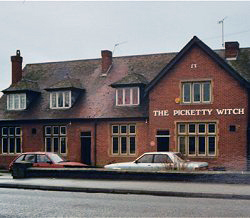 |
Picketty Witch The
Picketty
Witch
was
built in
the
1930's
by N&C
Partridge
Ltd, of
North
Lane, to
serve
the
rapidly
expanding
housing
in the
vicinity.
The late
1960's
pop
group,
Pickettywitch,
named
themselves
after
the pub
after
visiting
on the
way back
from a
gig. The
Picketty
Witch
finally
closed
in late
2012 and
was
converted
into yet
another
Tesco
Express. |
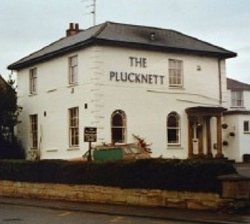 |
The Plucknett started as a private residence, called Preston House, being turned into a hotel during the mid-20th century.
Although
it has
traded
as a
hotel in
the
past, it
was
styled
as a
'traditional
pub'
with no
hint of
accommodation.
From its
appearance,
the
Plucknett
was
probably
built
around
1840. |
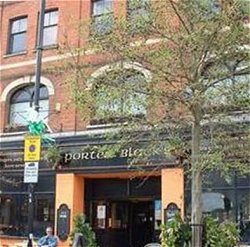 |
Porter Black's was a relatively short-lived Irish theme pub that opened around 1995 and closed in 2006. It is currently (2022) vacant. The
large
three-storey
corner
building
in the
Triangle
was
erected
for the
Co-operative
Society
as
offices
and
retail
space in
1910 and
has been
occupied
by many
businesses
during
the
years. |
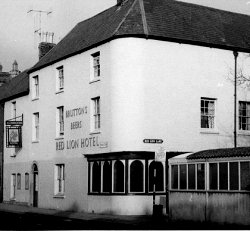 |
Although
the
earliest
reference
dates to
1667, it
had
probably
been an
inn for
many
years
before
that.
Having
said
that,
the Red
Lyon of
1667 may
have
been at
a
different
location
or an
earlier
building.
Certainly
the Red
Lion in
Kingston
was
shown on
Edward
Bullock
Watts'
map of
1804 and
has
verified
licensees
from the
1820s.
The Red
Lion was
demolished
in 1966
as part
of the
widening
of
Reckleford
and
Kingston. |
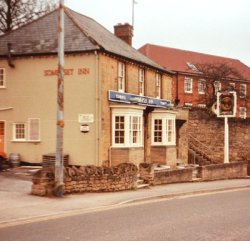 |
The records of the Somerset Inn begin in 1841. The inn sign was the badge of the local regiment, the Somerset Light Infantry or, as they were known in the 1850's, the 13th Prince Albert's Regiment of Light Infantry. The Somerset Inn closed around the year 2000. It was demolished and a block of flats, Somerset Court, now stands on the site. |
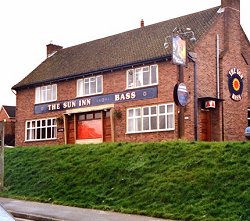 |
Sun Inn The Sun Inn was built in the mid-1950's to serve the local area where much inter- and post-war housing was being developed. In that sense it was a typical uninspiring 'estate' pub of the period. The Sun Inn closed in 2003 and was quickly demolished in early 2004, despite local protestations, and replaced with a block of flats, Seymour Court. |
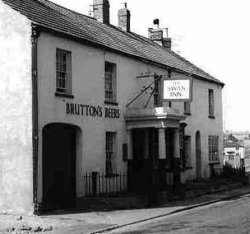 |
The Swan Inn was one of Yeovil's first beerhouses, opening in March 1830, in the wake of the Beerhouse Act 1830. In the early twentieth century the Swan was owned by Brutton's Brewery, later Brutton, Mitchell Toms Ltd. who were taken over by Charrington & Co Ltd, London, in 1960. It was around this time that the Swan ceased trading. Today the building is the Swan Theatre. |
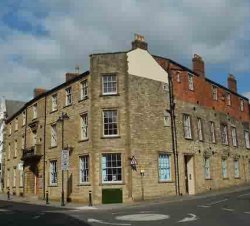 |
The records clearly indicate that the Three Choughs was operating by 1664. The building, as well as other licensed premises (the Pall Tavern and the George Inn), was at one time owned by the Woborn Almshouse and the rent of the building provided income for the Almshouse. The Three Choughs closed in 2004 and has since been converted into offices and flats. |
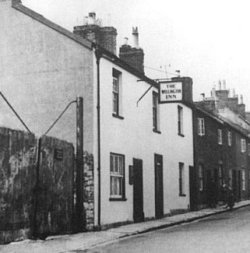 |
Wellington Inn The Wellington Inn was two-thirds of the white building in the photo at left and the plans show it had a servery with a wall hatch to the bar, a smoke room and a private room which was probably the private living room for the landlord. The Wellington Inn was demolished around 1968 to clear the area for the construction of the Wellington Street flats. |
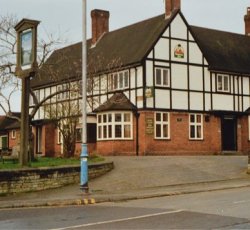 |
The Westfield Hotel opened in January 1938 and was a purpose-built establishment catering for the large housing estates built in the inter-war period in the area of Coronation Avenue, Stiby Road and Westfield Road. The Westfield Hotel was demolished in September 1996 and flats, Raglan Terrace, was built on the site in 1998. |
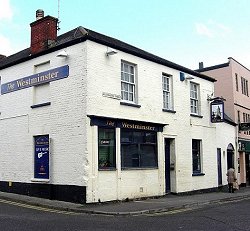 |
The Westminster The Westminster had been trading as a beerhouse since at least 1861, with a short break in the late 1960's when it was used as offices by Bass Charrington. It started life as the Heart of Oak, changing to the Hearts (plural) of Oak after the Second World War. |
It spent a while in the late 1970's as the Yeovil Wine Bar and it had a brief spell as the Chopper Bar in the late 1980’s, since when it was called the Westminster - finally closing in the spring of 2022.
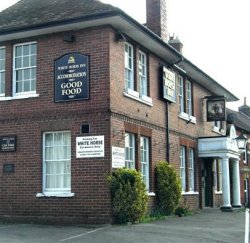 |
White Horse The earliest record of the White Horse dates back to 1851, although not in the present building which dates to around 1900. A tied house of Brutton's Brewery of Yeovil, it was acquired by Charrington & Co Ltd in 1960. The White Horse closed in 2009 and has been converted into flats. |
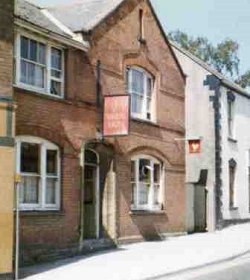 |
The White Lion building seen here was not the original building and probably dated to the 1890s. In March 1930 the Western Gazette published a contribution from a Yeovilian in which he wrote "Fifty years ago the White Lion Inn and adjoining shop were a long, low thatched roof building. In those bygone days a thatched roof was a very common sight." The White Lion closed in the early 1970s. |
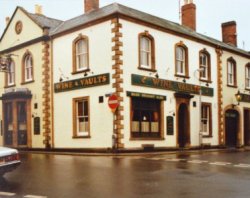 |
The early history of the Wine Vaults is somewhat complicated; it was certainly operating in 1824 as a wine merchant's but appears to have operated as a tavern as well throughout the 19th century. The present building dates from 1877. The Wine Vaults shut as a pub in 2007 and has since gone through several guises as a café / mezze bar. |
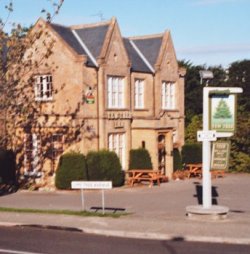 |
Yew Tree Inn Built in the second half of the nineteenth century, the Yew Tree Inn was originally the farmhouse of Yew Tree Farm. The Forest Hill area was developed from 1967, with a small shopping centre, church and community centre. It
was felt
by the
developers
and
brewers
Eldridge
Pope of
Dorchester,
that a
public
house
would be
a useful
addition
to the
area.
|
It closed sometime during the early 2000's and reopened briefly as the horrendously overpriced 'La Olivia' restaurant which, not surprisingly, failed miserably. It then briefly reopened as a public house, but finally closed on 26 June 2004.
![]()
